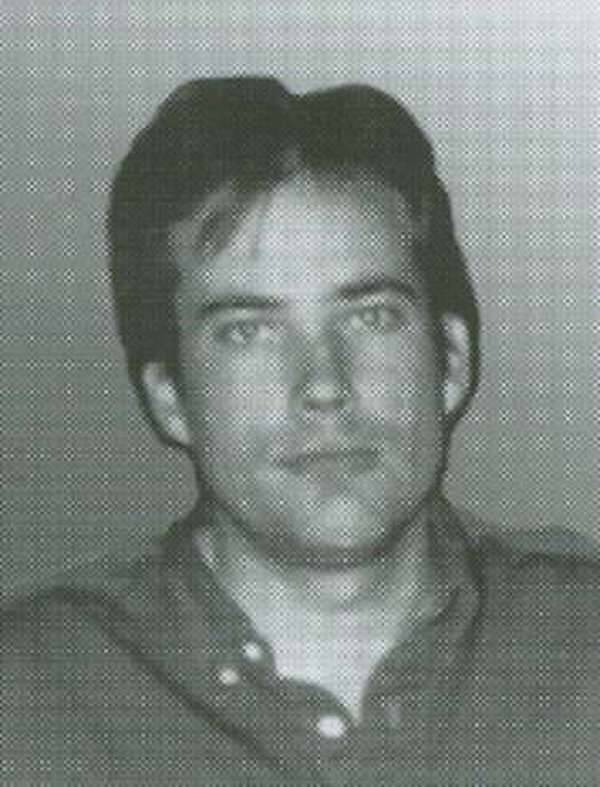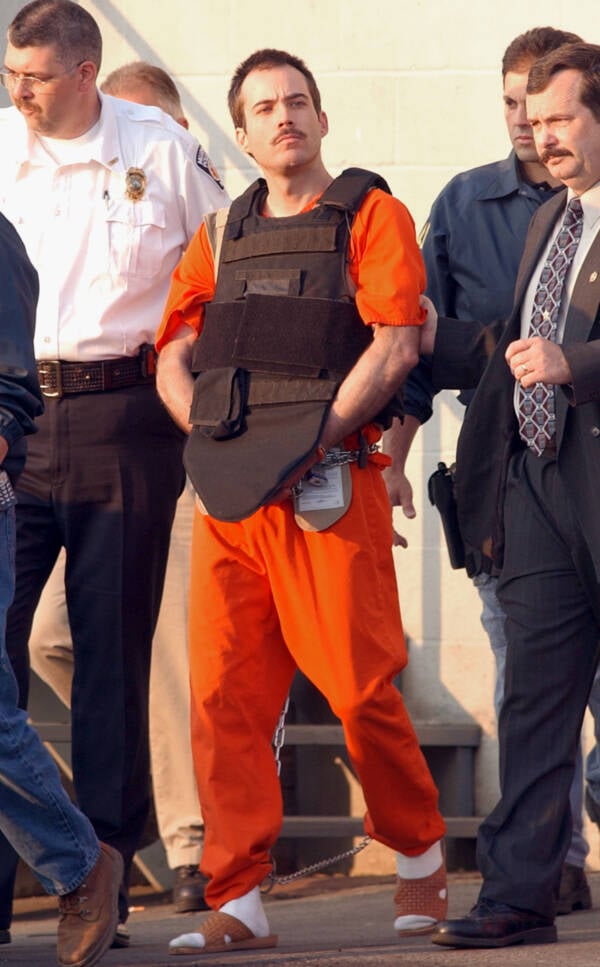On July 27, 1996, Eric Rudolph planted a bomb at Centennial Olympic Park in Atlanta, Georgia. He then targeted two abortion clinics and a lesbian bar before vanishing into the North Carolina wilderness.
On July 27, 1996, Eric Rudolph planted a bomb at Centennial Olympic Park in Atlanta, Georgia — one week into the Summer Olympics. The horrific explosion sent shrapnel flying in every direction, hitting countless innocent spectators. One woman died in the initial blast, while one man later died of a heart attack. And 111 other people were injured.
It would take two years for Rudolph to be identified and placed on the FBI’s Ten Most Wanted list. Until then, authorities were at a loss. Even worse, reports surfaced that the FBI had made Richard Jewell — the security guard who had found the bomb just before it exploded — their prime suspect. Meanwhile, Eric Rudolph allegedly went on to do three more bombings.

FBIThe manhunt for Eric Rudolph, aka the Atlanta Bomber, took five years and cost $24 million.
Months after Rudolph targeted an abortion clinic in Alabama on January 29, 1998, the FBI amassed enough evidence to identify him. But by that point, the Atlanta Bomber had already vanished into the Appalachian wilderness — while the FBI spent five years and $24 million trying to find him.
After he was finally captured in 2003, Eric Rudolph would later plead guilty to four bombings: Olympic Park, an abortion clinic in Atlanta, a lesbian bar in Atlanta, and an abortion clinic in Birmingham, Alabama. Rudolph would later explain that his motivation for the bombings was political. It was meant to be a violent protest against abortion in America, as well as gay rights.
But while this case was largely closed after Rudolph’s conviction, many people still have questions. How did Eric Rudolph survive on the run for so long — especially in the unforgiving wilderness? Did he have help from any sympathetic locals? Did Eric Rudolph kill anyone in the woods? What happened to him after he got caught? And where is Eric Rudolph today?
The Turbulent Early Years Of Eric Rudolph

Wikimedia CommonsEric Rudolph killed at least three people and injured more than 100 in his bombings.
Born on September 19, 1966, in Merritt Island, Florida, Eric Robert Rudolph grew up with parents who were surprisingly pacifist. In fact, his mother and father had first met while they were protesting against the Vietnam War. Christianity was also a huge part of the family’s life, but their faith in God was tested when Rudolph’s father died of cancer in 1981.
Rudolph was 15 years old when his dad died, which fostered his anger at God as well as the government — because they didn’t approve a risky drug that Rudolph firmly believed would have saved his father. Still, his widowed mother was eager to start fresh and moved the family to Nantahala, North Carolina, where Rudolph’s radicalization arguably began.
An impressionable teenager, Eric Rudolph spent a lot of time with his neighbor Thomas Wayne Branham. His friend detested the government and always kept an arsenal of dangerous weapons on hand, which the Bureau of Alcohol, Tobacco, and Firearms actually raided when Rudolph was 17.
By then, Rudolph had already dropped out of high school. On Branham’s suggestion, he spent four months with an anti-Semitic, racist, and homophobic preacher in Missouri. While he later returned to North Carolina to get his GED and attend college, he dropped out to join the U.S. Army.
Stationed at Fort Campbell in Kentucky with the 101st Airborne Division, Rudolph learned quite a bit about explosives while he was there. But his career as a soldier was not a long one, since he was discharged for marijuana use in 1989. He then returned to Nantahala and worked in carpentry — while becoming increasingly paranoid about the government.
Throughout the years, Rudolph explored various types of white supremacist, anti-Semitic, and anti-gay groups, most notably Christian Identity — a movement whose “most fundamental teaching pivots on the idea that Anglo-Saxons are the direct descendants of the Ten Lost Tribes of Israel and, thus, are the ‘true chosen people’ of God.”
Guided by his lack of trust in the government and his increasingly extremist views, Eric Rudolph made a fateful decision in 1996.
How Eric Rudolph Became The Atlanta Bomber

GEORGES GOBET/AFP/Getty ImagesCentennial Park, pictured moments after the explosion.
In 1996, Eric Rudolph began using aliases like “Bob Randolph” and “Bob Rudolph.” The 29-year-old was presumably aware that he would soon be on the run, as he planned to target the Summer Olympics on July 27th.
As he later explained, the purpose of this attack “was to confound, anger, and embarrass the Washington government in the eyes of the world for its abominable sanctioning of abortion on demand.”
Dressed in jeans and a blue short-sleeve shirt, Rudolph placed a backpack with three pipe bombs filled with gunpowder and nails underneath a bench at the Olympics venue in Atlanta. He reached inside to set an alarm for 55 minutes and left. Then, he allegedly made a 911 call from a nearby payphone.
“There is a bomb in Centennial Park,” he said. “You have 30 minutes.”
By that point, security guard Richard Jewell had already noticed the bag and helped clear the immediate area of bystanders. Jewell also flagged down Tom Davis, a Georgia Bureau of Investigation agent who was also working security that night. Davis immediately agreed that the bag was suspicious.
After the bomb team confirmed their worst fears, Jewell and others ordered everyone in the area to evacuate. Soon, the bag exploded. It was 1:25 a.m.

Pool/Getty ImagesOne of the Atlanta bombing victims on July 27, 1996.
“It knocked me forward, and I fell down on my hands and knees,” recalled Jewell. “As I pushed myself back up, I looked to my right because that’s where the blast come from. Those troopers that had been lined up with those benches were flying through the air. It had knocked them that far.”
Tragically, one woman named Alice Hawthorne died shortly after the blast when one of the nails penetrated her skull. A Turkish cameraman named Melih Uzunyol also died of a heart attack after he rushed to the scene. And 111 other people in the crowd were injured by the shrapnel.
While Richard Jewell was initially hailed a hero for his quick thinking — which certainly prevented more deaths — he was soon viewed with suspicion after he was falsely accused of plotting the attack himself. So for 88 days, all eyes were on Jewell as he was investigated as a potential suspect.
Meanwhile, Eric Rudolph headed back to North Carolina, with the authorities none the wiser. As the FBI focused on Jewell, Rudolph allegedly planned his next three bombings: an abortion clinic and a lesbian nightclub in Atlanta in early 1997, and another abortion clinic in Alabama in January 1998.
Inside The Manhunt For The Real Culprit

Flickr/Charles (Chuck) PetersonNantahala National Forest, where Rudolph spent much of his time on the run, spans 830 square miles.
Eric Rudolph had killed two and injured 111 people at the Olympic Games. In addition, he had injured seven people at the Atlanta abortion clinic and injured four at the nightclub. And he had also killed a 35-year-old off-duty police officer named Robert Sanderson at the Alabama abortion clinic.
Fortunately, witnesses had seen Rudolph’s truck leave just before his last explosion, resulting in a federal warrant for his arrest on February 14, 1998. Rudolph’s brother Daniel felt his family was being unfairly persecuted, and bizarrely opted to cut his hand off with a circular saw in protest.
Meanwhile, the FBI placed Eric Rudolph on their Ten Most Wanted list in May with a $1 million reward. And on October 14, 1998, Rudolph was formally charged with all four bombings — while he was still on the loose. Though authorities pulled out all the stops to find him — using everything from bloodhounds to heat-sensing helicopters to electronic motion detectors — he successfully remained in hiding for five years.
Before Rudolph vanished, he was last seen at the Nantahala home of a health food store owner named George Nordmann on July 7, 1998. Rudolph was there to ask for food and supplies. While Nordmann initially agreed to help him, he changed his mind and reported him a few days later.
Still, there were issues with the search right off the bat. It was widely believed that Rudolph was hiding out in the massive Nantahala National Forest — which spans 830 square miles — but it was unclear where exactly he would set up camp. In addition, there was also some tension between federal authorities and people who lived in the region.

FBISome of Eric Rudolph’s hidden dynamite, which was later recovered by the FBI in April 2005.
“The FBI is keeping it pretty hush,” complained a local assistant police chief named Chris West. “We could have given them help with the terrain, shown them spots they need to check out — caves, caverns, old mountain homes. But they haven’t asked us.”
“It seemed to me like a farce more than anything else,” suggested a local carpenter named Doug Franklin. “They had coffee pots set up on the side of the road, and you’d see them sitting or standing there and their uniforms were perfectly clean. No dirt on it, just a clean uniform. So that told me that they hadn’t been very far out in the woods looking for him.”
Overall, many residents and local authorities appeared to view the FBI with skepticism and even suspicion. They openly wondered how much federal authorities were actually doing to find Rudolph, especially since many of them were unfamiliar with the local wilderness. Some even suggested that the FBI was really only there for publicity and training exercises.
And as for the FBI, they believed that some of the locals sympathized with Rudolph — particularly those who held anti-abortion views. Ominously, some authorities even suspected residents of helping Rudolph. They simply couldn’t fathom that he could survive in the wilderness on his own.
And as time dragged on, many simply believed that Rudolph had died at some point while he was on the run. But they were wrong.
Is Eric Rudolph Still Alive?

Erik S. Lesser/Getty ImagesEric Rudolph being escorted for a hearing in Asheville, North Carolina on June 2, 2003.
At the height of the search, hundreds of agents combed the Nantahala National Forest. But by 2000, the manhunt had been scaled back. And by 2002, the search was essentially comprised of just a dozen agents.
Eric Rudolph was finally captured on May 31, 2003 — but not by an FBI agent. Instead, it was a local rookie police officer who arrested him (not that the cop knew who he was). And it was by mere chance that 21-year-old Jeffrey Postell put an end to the manhunt.
When Postell arrested a vagrant — who identified himself as “Jerry Wilson” — for stealing food from a dumpster, he had no idea that he had actually caught Eric Rudolph. It was only when they got to the station that other cops looked at Rudolph’s wanted poster and put two and two together. Rudolph cackled and admitted: “I’m Eric Robert Rudolph, and you’ve got me.”
Many Americans were stunned to hear that the Atlanta Bomber had finally been captured. And naturally, they had questions. For one, how did he survive in the woods for so long? As Rudolph later told it, he split his time between a “summer camp” and a “winter camp” in different areas of the wilderness. He hunted local wildlife for food, stole necessities from unoccupied homes, and slept on the ground most nights. Or so he says.
While there’s no official evidence that Rudolph received help while he was on the run — and the mayor of a nearby town denied that anyone gave him assistance — some believe that he must have had at least a couple of allies who lent a hand in order for him to survive so long.
On the flip side, the idea of the Atlanta Bomber interacting with people after conducting multiple brutal attacks leads to another ominous question: Did Eric Rudolph kill anyone in the woods? Currently, there is no evidence that he did. But much like the question of whether he received help, some believe that he never put an end to his brutality until he was caught.
After about two years of Rudolph being in custody, it was announced in 2005 that he had agreed to a plea bargain. He would plead guilty to all four bombings and waive his appeals. In exchange, he would avoid the death penalty. And on July 18th, Rudolph was given four life sentences.
Eric Rudolph explained in a statement five days later that his bombings were meant to urge the government to outlaw abortions and to resist giving gay people more rights. Of course, his plans were complete failures and also robbed innocent people of their lives.
But as for Eric Rudolph, he is still alive today. Now 54 years old, the Atlanta Bomber is serving his life sentence at the ADX Florence Supermax prison in Colorado. He is expected to spend the rest of his days there.
After learning about Eric Rudolph, read about David Copeland, the terrorist behind the London nail bombings. Then, take a look at Mark Hofmann, the Salt Lake City bomber who killed to cover up his counterfeiting career.





